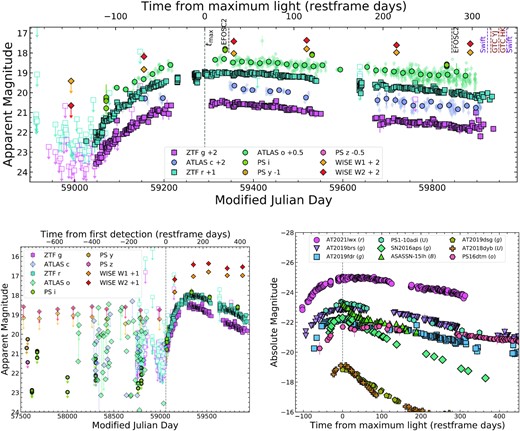I note from the MNRAS link, “Throughout the paper, we use ‘days’ to refer to the observer frame and ‘d’ for the rest frame at z = 0.9945. All photometry is corrected for Galactic foreground extinction according to Schlafly & Finkbeiner (2011) assuming a Fitzpatrick (1999) extinction curve. Magnitudes are presented in the AB system (Oke & Gunn 1983). Upper limits are reported at the 3σ level, while uncertainties are 1σ. Where necessary, we assume a spatially flat Lambda cold dark matter cosmological model with H0 = 70 km s^−1 Mpc^−1 and ΩM = 0.3.”
This sets the framework and foundation for the model explanation and calculations. Using cosmology calculators for those values, look back time distance is 7.693 billion light-years (from Earth), comoving radial distance 10.735 billion light-years (from Earth) where space expands at nearly 77% c velocity for H0 = 70 km/s/Mpc. The age at z=0.9945 is 5.770 billion years old. I like to keep things like this in mind when reading these reports and energy levels presented. The abstract states the energy levels using c.g.s. units.
“ABSTRACT We present observations from X-ray to mid-infrared wavelengths of the most energetic non-quasar transient ever observed, AT2021lwx. Our data show a single optical brightening by a factor >100 to a luminosity of 7 × 10^45 erg s^−1 and a total radiated energy of 1.5 × 10^53 erg, both greater than any known optical transient. The decline is smooth and exponential and the ultraviolet–optical spectral energy distribution resembles a blackbody with a temperature of 1.2 × 10^4 K. Tentative X-ray detections indicate a secondary mode of emission, while a delayed mid-infrared flare points to the presence of dust surrounding the transient. The spectra are similar to recently discovered optical flares in known active galactic nuclei but lack some characteristic features. The lack of emission for the previous 7 yr is inconsistent with the short-term, stochastic variability observed in quasars, while the extreme luminosity and long time-scale of the transient disfavour the disruption of a single solar-mass star. The luminosity could be generated by the disruption of a much more massive star, but the likelihood of such an event occurring is small. A plausible scenario is the accretion of a giant molecular cloud by a dormant black hole of 10^8–10^9 solar masses. AT2021lwx thus represents an extreme extension of the known scenarios of black hole accretion.” MNRAS reference.
ABSTRACT. We present observations from X-ray to mid-infrared wavelengths of the most energetic non-quasar transient ever observed, AT2021lwx. Our data show a si

academic.oup.com



